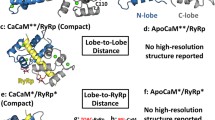Abstract
The high-affinity Ca2+–binding sites of carp (pI 4.25) and pike (pI 5.0) parvalbumins, as well as those of mammalian calmodulin (CaM) and its C-terminal tryptic half-molecule (TR2C), were analyzed by 207Pb NMR spectroscopy. For the parvalbumins, two 207Pb signals were observed ranging in chemical shift from ≈750 to ≈1260 ppm downfield of aqueous Pb(NO3)2, corresponding to 207Pb2+ bound to the two high-affinity helix-loop-helix Ca2+–binding sites in each of these proteins. Four 207Pb signals, which fall in the same chemical shift window, could be discerned for CaM. Experiments on TR2C permitted the assignment of each signal as due to 207Pb2+ occupying a helix-loop-helix site in either the N- or the C-lobe of the intact protein. 207Pb and 1H NMR titration studies on CaM provided evidence that Pb2+ binding to all four sites occurs simultaneously, in contrast to the behavior of this protein in the presence of Ca2+. Titrations of the 207Pb2+–forms of CaM and TR2C with the antipsychotic drug trifluoperazine demonstrated that drug binding to the exposed hydrophobic surfaces in CaM causes substantial conformational changes and proceeds in a sequential manner – first the C-lobe and subsequently the N-lobe. Finally, the field dependence of CaM-bound 207Pb signals was examined. The 207Pb signal linewidths exhibited a sharp dependence on the square of the external magnetic field, a trend characteristic of relaxation via chemical shift anisotropy. Relaxation studies on TR2C demonstrated that chemical exchange also contributes to the observed linewidths. The large chemical shift dispersion observed for the 207Pb signals of the three proteins studied here illustrates the remarkable sensitivity of this parameter to subtle differences in the chemical environment of the protein-bound 207Pb nucleus. To our knowledge, the data presented in this article comprise the first ever published example of the application of 207Pb NMR spectroscopy to metalloproteins.
Similar content being viewed by others
Author information
Authors and Affiliations
Rights and permissions
About this article
Cite this article
Aramini, J., Hiraoki, T., Yazawa, M. et al. Lead-207 NMR: a novel probe for the study of calcium-binding proteins. JBIC 1, 39–48 (1996). https://doi.org/10.1007/s007750050021
Issue Date:
DOI: https://doi.org/10.1007/s007750050021




